肯尼亚ICT行业市场调查报告英文
市场调查报告英文

市场调查报告英文Market Research ReportIntroduction:The purpose of this market research report is to analyze and evaluate the current trends and dynamics in the market. By conducting thorough research and analysis, we aim to provide valuable insights and recommendations for businesses operating in this industry.1. Overview of the Market:The market under study is the consumer electronics industry, which includes products such as smartphones, tablets, laptops, and wearable devices. This industry has witnessed significant growth in recent years due to technological advancements and changing consumer preferences.2. Market Size and Growth:According to our research, the global consumer electronics market was valued at $X billion in 2020 and is projected to reach $Y billion by 2025, growing at a CAGR of Z%. The increasing demand for innovative and connected devices, coupled with the rising disposable income of consumers, is driving this growth.3. Key Players:The market is highly competitive, with several key players dominating the industry. Companies like Apple, Samsung, Huawei, and Xiaomi have established a strong foothold in the market through their innovative products and effective marketing strategies. These players constantly invest in research anddevelopment to stay ahead of the competition.4. Consumer Behavior and Preferences:Our research indicates that consumers are increasingly seeking products that offer convenience, connectivity, and enhanced functionality. They prioritize features such as long battery life, high-resolution displays, and seamless integration with other devices. Additionally, eco-friendly and sustainable products are gaining popularity among environmentally conscious consumers.5. Emerging Technologies:The consumer electronics industry is witnessing rapid technological advancements. Some of the emerging technologies that are expected to shape the market include artificial intelligence, augmented reality, virtual reality, and 5G connectivity. These technologies have the potential to revolutionize the way consumers interact with their devices.6. Market Challenges:While the market offers immense opportunities, it also faces certain challenges. One of the key challenges is the increasing competition from low-cost manufacturers, particularly from countries like China. These manufacturers offer affordable alternatives to well-established brands, posing a threat to their market share. Additionally, concerns regarding data privacy and security are becoming more prominent, affecting consumer trust in connected devices.7. Market Opportunities:Despite the challenges, there are several opportunities for businesses operatingin this industry. The growing demand for smart home devices, wearable technology, and healthcare-related electronics presents significant growth prospects. Furthermore, expanding into emerging markets, such as India and Southeast Asia, can provide access to a large consumer base.8. Recommendations:Based on our research findings, we recommend that companies focus on innovation and differentiation to stay competitive. Investing in research and development to introduce cutting-edge products will help attract and retain customers. Additionally, companies should prioritize sustainability and ethical practices to cater to the growing demand for eco-friendly products. Conclusion:In conclusion, the consumer electronics market is witnessing steady growth and evolving consumer preferences. By understanding the market dynamics and leveraging emerging technologies, businesses can capitalize on the opportunities and overcome the challenges. Continuous research and adaptation to changing consumer needs will be crucial for long-term success in this industry.。
英语作文-集成电路设计行业的国内外市场对比与竞争态势
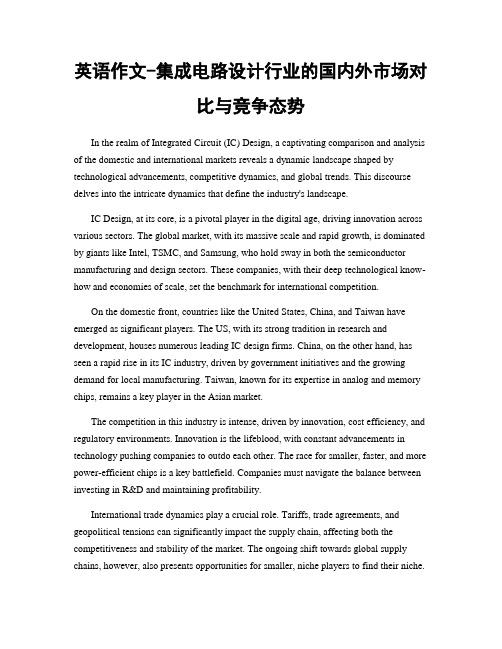
英语作文-集成电路设计行业的国内外市场对比与竞争态势In the realm of Integrated Circuit (IC) Design, a captivating comparison and analysis of the domestic and international markets reveals a dynamic landscape shaped by technological advancements, competitive dynamics, and global trends. This discourse delves into the intricate dynamics that define the industry's landscape.IC Design, at its core, is a pivotal player in the digital age, driving innovation across various sectors. The global market, with its massive scale and rapid growth, is dominated by giants like Intel, TSMC, and Samsung, who hold sway in both the semiconductor manufacturing and design sectors. These companies, with their deep technological know-how and economies of scale, set the benchmark for international competition.On the domestic front, countries like the United States, China, and Taiwan have emerged as significant players. The US, with its strong tradition in research and development, houses numerous leading IC design firms. China, on the other hand, has seen a rapid rise in its IC industry, driven by government initiatives and the growing demand for local manufacturing. Taiwan, known for its expertise in analog and memory chips, remains a key player in the Asian market.The competition in this industry is intense, driven by innovation, cost efficiency, and regulatory environments. Innovation is the lifeblood, with constant advancements in technology pushing companies to outdo each other. The race for smaller, faster, and more power-efficient chips is a key battlefield. Companies must navigate the balance between investing in R&D and maintaining profitability.International trade dynamics play a crucial role. Tariffs, trade agreements, and geopolitical tensions can significantly impact the supply chain, affecting both the competitiveness and stability of the market. The ongoing shift towards global supply chains, however, also presents opportunities for smaller, niche players to find their niche.The competition is not just within the industry, but also with emerging technologies like 5G, AI, and the Internet of Things (IoT). These sectors are driving a surge in IC demand, creating a fertile ground for growth and innovation. Companies must adapt to these changes to stay relevant.In conclusion, the IC Design industry, with its global and domestic markets, is a dynamic and competitive arena. The future is shaped by the relentless pursuit of innovation, the evolving regulatory landscape, and the relentless drive for technological superiority. As the industry continues to evolve, it promises to be a fascinating journey, where both established players and new entrants vie for dominance in the digital age.。
行业市场分析报告英文模板
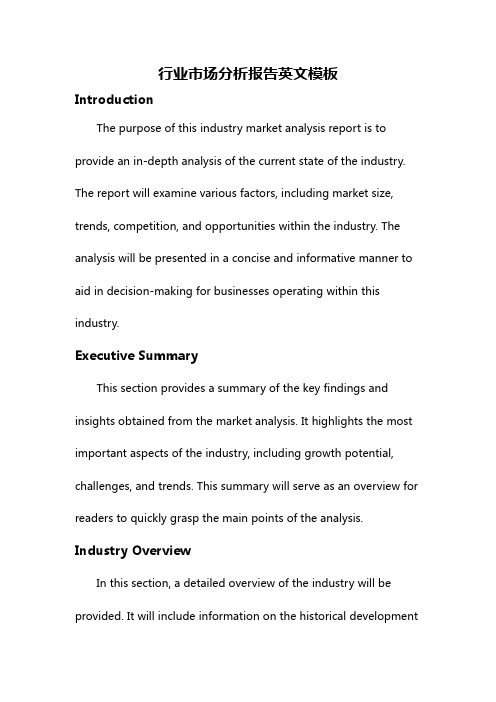
行业市场分析报告英文模板IntroductionThe purpose of this industry market analysis report is to provide an in-depth analysis of the current state of the industry. The report will examine various factors, including market size, trends, competition, and opportunities within the industry. The analysis will be presented in a concise and informative manner to aid in decision-making for businesses operating within this industry.Executive SummaryThis section provides a summary of the key findings and insights obtained from the market analysis. It highlights the most important aspects of the industry, including growth potential, challenges, and trends. This summary will serve as an overview for readers to quickly grasp the main points of the analysis. Industry OverviewIn this section, a detailed overview of the industry will be provided. It will include information on the historical developmentof the industry, its current status, and potential future direction. This section aims to provide readers with a clear understanding of the industry's background and context.Market Size and GrowthIn this section, the market size and growth trends of the industry will be analyzed. Data from various sources, including industry reports and market research, will be used to provide accurate and up-to-date information. The analysis will focus on both historical and projected market size, as well as the key drivers and inhibitors of growth within the industry.Market TrendsThis section will analyze the current market trends within the industry. It will examine factors such as technological advancements, regulatory changes, and shifting consumer preferences. The analysis will help businesses identify key trends that can impact their strategies and decision-making. Competitive LandscapeThe competitive landscape of the industry will be analyzed inthis section. It will provide an overview of the major players in the industry, their market share, and key strategies. The analysis will also include an examination of barriers to entry and potential opportunities for new entrants.Opportunities and ChallengesThis section will identify the opportunities and challenges within the industry. It will highlight potential growth areas and emerging markets, as well as any obstacles that businesses may face. The analysis will help businesses navigate the industry landscape and make informed decisions.ConclusionThe industry market analysis report aims to provide a comprehensive and accurate analysis of the industry. It presents a detailed overview of the industry, including market size, trends, competition, and opportunities. The report will assist businesses in understanding the dynamics of the industry and making informed decisions to achieve their objectives.References1. Industry Report ABC, XYZ Research, 2021.2. Market Research Report 123, Market Insights Inc., 2021.3. Industry Statistics Data, National Statistical Agency, 2021.Please note that the above information is for illustrative purposes only and does not reflect real market data.。
印尼市场调研英文版本

Indonesia Overview
GDP (USD bn)
2011 2012 2013 2014
845
876
868
889
GDP per capita (USD) 1,570 1,645 1,723 1,797
Unemployment Rate
0.66
0.61
0.59
0.58
The Indonesian economy is the world's 16th largest by nominal GDP and the 8th largest by PPP. And it is the largest economy in Southeast Asia and a member of the G-20 major economies.
TOTAL POPULATION
THAT ARE PRE-PAID THAT ARE POST-PAID BROADBAND(3G & 4G)
281.9M 112% 99%
1%
34%
Mobile Market
Samsung is the most popular smartphone in Indonesia with highest PBI score of 51.6(PBI=Popular Brand Index) Local brands are very aggressive in marketing, like Smartfren and Advan.
Religions: Islam 87%, Christianity 6.1%, Catholic 3.6%, other 3.3%
Languages: Bahasa, English (secondary language of the elite), ethnic and regional dialects
国外市场分析英文报告
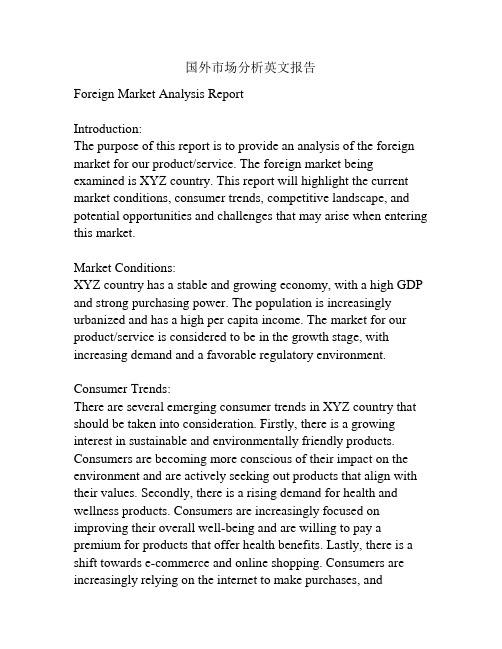
国外市场分析英文报告Foreign Market Analysis ReportIntroduction:The purpose of this report is to provide an analysis of the foreign market for our product/service. The foreign market being examined is XYZ country. This report will highlight the current market conditions, consumer trends, competitive landscape, and potential opportunities and challenges that may arise when entering this market.Market Conditions:XYZ country has a stable and growing economy, with a high GDP and strong purchasing power. The population is increasingly urbanized and has a high per capita income. The market for our product/service is considered to be in the growth stage, with increasing demand and a favorable regulatory environment. Consumer Trends:There are several emerging consumer trends in XYZ country that should be taken into consideration. Firstly, there is a growing interest in sustainable and environmentally friendly products. Consumers are becoming more conscious of their impact on the environment and are actively seeking out products that align with their values. Secondly, there is a rising demand for health and wellness products. Consumers are increasingly focused on improving their overall well-being and are willing to pay a premium for products that offer health benefits. Lastly, there is a shift towards e-commerce and online shopping. Consumers are increasingly relying on the internet to make purchases, andcompanies that have a strong online presence are more likely to succeed in this market.Competitive Landscape:The competitive landscape in XYZ country is highly fragmented, with a mix of local and international companies. Local companies dominate certain segments of the market, while international companies have a strong presence in others. The key competitors in the market include Company A, Company B, and Company C. These companies have a strong brand reputation and a wide distribution network. However, they may not have the same level of innovation or customer service as our company, which presents an opportunity for us to differentiate ourselves and gain market share.Opportunities and Challenges:Entering the XYZ country market presents several opportunities and challenges. The growing economy and consumer trends mentioned earlier provide an opportunity for us to introduce our sustainable and health-focused products. Additionally, the fragmented competition allows us to carve out a niche market and target specific consumer segments. However, there are also challenges that need to be addressed. The regulatory environment may differ from our home country, requiring us to adapt our product or business model. Additionally, cultural differences and language barriers may impact our ability to effectively communicate and market our product/service.Conclusion:Overall, the foreign market in XYZ country presents a promisingopportunity for our product/service. The stable economy, emerging consumer trends, and fragmented competition create a favorable environment for us to enter and establish ourselves. However, it is critical to address the potential challenges and adapt our strategy accordingly to ensure success in this market.。
ict 行业报告

ict 行业报告ICT Industry Report。
Introduction。
The ICT (Information and Communication Technology) industry plays a crucial role in the modern economy, driving innovation, productivity, and efficiency across various sectors. This report aims to provide an overview of the current state of the ICT industry, including key trends, challenges, and opportunities.Global ICT Market Overview。
The global ICT market has been experiencing steady growth in recent years, driven by increasing demand for digital transformation, cloud computing, big data analytics, and artificial intelligence. According to a report by Market Research Future, the global ICT market is projected to reach a value of USD 6.5 trillion by 2025, with a CAGR of 8.3% from 2019 to 2025.Key Trends in the ICT Industry。
Several key trends are shaping the ICT industry, including:1. Digital Transformation: Organizations are increasingly adopting digital technologies to streamline their operations, enhance customer experiences, and gain a competitive edge. This includes the adoption of cloud-based solutions, IoT (Internet of Things) devices, and automation technologies.2. 5G Technology: The rollout of 5G networks is set to revolutionize the ICT industry, enabling faster data speeds, lower latency, and greater connectivity. This will drive the development of new applications and services, particularly in the areas of IoT, smart cities, and autonomous vehicles.3. Artificial Intelligence and Machine Learning: AI and ML technologies are being integrated into various ICT solutions, enabling advanced analytics, predictive maintenance, and personalized customer experiences.4. Cybersecurity: With the increasing volume and sophistication of cyber threats, cybersecurity has become a top priority for organizations. The ICT industry is witnessing growing demand for robust security solutions to protect data and systems from cyber attacks.Challenges Facing the ICT Industry。
通讯行业报告模板英语

通讯行业报告模板英语Title: Communication Industry Report Template in English。
Introduction。
The communication industry is a rapidly evolving sector that encompasses a wide range of technologies and services. From traditional telecommunication networks to the latest advancements in wireless and digital communication, this industry plays a vital role in connecting people and businesses around the world. This report aims to provide a comprehensive overview of the current state of the communication industry, including key trends, challenges, and opportunities.Industry Overview。
The communication industry is a diverse and dynamic sector that includes various sub-segments such as telecommunications, internet services, broadcasting, and digital media. The global communication industry has witnessed significant growth in recent years, driven by technological advancements, increasing demand for connectivity, and the proliferation of digital devices. According to industry reports, the global communication industry is expected to reach a market value of over $2 trillion by 2025, with a compound annual growth rate of 5.2%.Key Trends。
关于移动通信行业的趋势分析(英文版)
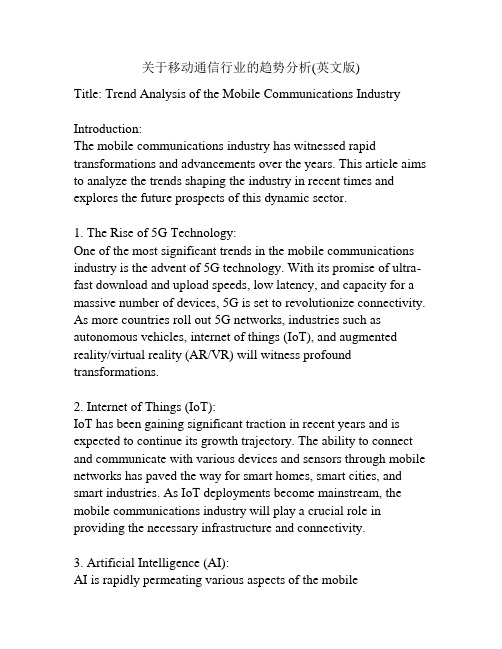
关于移动通信行业的趋势分析(英文版)Title: Trend Analysis of the Mobile Communications Industry Introduction:The mobile communications industry has witnessed rapid transformations and advancements over the years. This article aims to analyze the trends shaping the industry in recent times and explores the future prospects of this dynamic sector.1. The Rise of 5G Technology:One of the most significant trends in the mobile communications industry is the advent of 5G technology. With its promise of ultra-fast download and upload speeds, low latency, and capacity for a massive number of devices, 5G is set to revolutionize connectivity. As more countries roll out 5G networks, industries such as autonomous vehicles, internet of things (IoT), and augmented reality/virtual reality (AR/VR) will witness profound transformations.2. Internet of Things (IoT):IoT has been gaining significant traction in recent years and is expected to continue its growth trajectory. The ability to connect and communicate with various devices and sensors through mobile networks has paved the way for smart homes, smart cities, and smart industries. As IoT deployments become mainstream, the mobile communications industry will play a crucial role in providing the necessary infrastructure and connectivity.3. Artificial Intelligence (AI):AI is rapidly permeating various aspects of the mobilecommunications industry, enabling more personalized and intelligent services. Virtual assistants, chatbots, and AI-powered analytics are just a few examples of how AI is reshaping the user experience. As AI technologies continue to advance, we can expect further integration of AI in mobile communication networks, resulting in enhanced network management, improved security, and better customer support.4. Mobile Money and Financial Services:Mobile payments and financial services have gained widespread adoption, particularly in emerging economies where traditional banking infrastructure may be limited. Mobile wallets and payment apps provide a convenient and secure platform for conducting financial transactions. The mobile communications industry is expected to play a critical role in expanding access to financial services and driving the growth of digital economies globally.5. Focus on Sustainability:Sustainability has become a significant concern across industries, and mobile communications is no exception. The industry is witnessing a shift towards more energy-efficient networks and devices, with a greater emphasis on recycling and reducing electronic waste. Renewable energy sources and energy-efficient infrastructure are being deployed. Additionally, mobile network operators are increasingly investing in green initiatives and partnering with organizations to promote e-waste recycling.6. Enhanced Security and Privacy:With the growing digitalization and increased connectivity, security and privacy concerns have become paramount. As cyberthreats continue to evolve, the mobile communications industry is focusing on fortifying security measures, such as improving encryption protocols, implementing biometric authentication, and ensuring robust data protection. Privacy and user consent are also gaining attention, leading to stricter regulations regarding user data collection and usage.Conclusion:The mobile communications industry is on an ever-evolving trajectory, driven by emerging technologies, changing consumer demand, and global trends. The rise of 5G, IoT, AI, mobile financial services, sustainability initiatives, and focus on security and privacy are shaping the future of this dynamic sector. As the industry continues to innovate, mobile communication networks will become even more integral to our daily lives, connecting people and devices in new and transformative ways.继续写相关内容,1500字7. Augmented Reality/Virtual Reality (AR/VR):The advent of 5G technology has spurred the growth of augmented reality and virtual reality applications. AR/VR has the potential to revolutionize various industries, including gaming, entertainment, education, and healthcare. With the high-speed and low latency capabilities of 5G networks, users can experience immersiveAR/VR content without any lag or buffering. The mobile communications industry is playing a pivotal role in expanding the reach of AR/VR applications by providing the necessary network infrastructure and bandwidth.8. Mobile Gaming:Mobile gaming has become a massive industry, fueled by the increasing processing power of smartphones and the widespread availability of high-speed mobile networks. The mobile communications industry is catering to the growing demand for mobile gaming by providing low-latency connections and high bandwidth to ensure a seamless gaming experience. Multiplayer gaming, cloud gaming, and e-sports are gaining popularity, driving the need for robust and fast mobile networks.9. Edge Computing:As data-intensive applications and services proliferate, the mobile communications industry is exploring edge computing solutions. Edge computing moves data processing and storage closer to the end-users, reducing latency and reliance on centralized cloud servers. With edge computing, mobile devices can offload complex computations to nearby edge servers, improving performance and enabling real-time applications. Edge computing is especially critical for emerging technologies like autonomous vehicles and IoT, where low latency is crucial for ensuring safety and responsiveness.10. Network Diversification:Traditionally, mobile communications networks have relied primarily on cellular networks. However, the industry is witnessing increasing diversification in network technologies. In addition to cellular networks like 5G, mobile communications are expanding to include technologies like Wi-Fi 6, satellite networks, and even non-traditional options like balloons and drones. This diversification allows for improved coverage, especially in rural and remote areas, and provides backup options in case of networkoutages or disasters.11. E-SIM and Remote SIM Provisioning:With the introduction of embedded SIM (e-SIM) technology and remote SIM provisioning (RSP), the mobile communications industry is transforming the way SIM cards are used and managed. E-SIM eliminates the need for physical SIM cards and allows users to switch carriers or plans without changing physical cards. RSP enables remote provisioning of SIM profiles, making it easier for users to switch between networks. These advancements simplify the process of connecting to mobile networks, increase flexibility, and enable new business models for mobile operators.12. Partnerships and Mergers:The mobile communications industry is experiencing a wave of partnerships and mergers as companies look to leverage synergies and strengthen their market position. Telecom operators are partnering with technology companies, content providers, and other industries to offer bundled services and create a seamless user experience. Mergers between telecom operators are also occurring to achieve economies of scale and invest in infrastructure and network expansion. These collaborations are expected to drive innovation, improve service offerings, and enhance competitiveness in the industry.13. Regulatory Policies and Spectrum Allocation:Regulatory policies and spectrum allocation play a vital role in shaping the mobile communications industry. Governments worldwide are actively involved in creating policies that promote competition, investment, and consumer protection. Spectrumallocation, particularly for 5G networks, is a critical consideration for mobile operators. Governments and regulatory bodies are working on spectrum auctions and allocations to ensure sufficient spectrum is available for mobile communication services and meet the increasing demand for data connectivity.14. Rural Connectivity and Digital Inclusion:While mobile communications have become ubiquitous in many urban areas, ensuring connectivity in rural and underserved areas remains a challenge. Closing the digital divide is a priority for governments and organizations globally. The mobile communications industry is actively working to extend network coverage and improve connectivity in rural areas through initiatives like rural broadband programs, shared mobile infrastructure, and satellite-based connectivity solutions. These efforts aim to bridge the digital gap and enable digital inclusion for all.15. Enhanced User Experience:User experience is at the forefront of mobile communications innovation. The industry is continuously striving to improve network performance, coverage, and reliability to offer a seamless and uninterrupted user experience. This includes advancements in network optimization, signal quality, and call quality. Mobile operators are also investing in technologies like carrier aggregation, beamforming, and small cells to enhance network capacity and speed, providing users with faster download and upload speeds, smoother video streaming, and better call quality.In conclusion, the mobile communications industry is undergoingrapid transformation driven by technological advancements and changing user demands. The rise of 5G, IoT, AI, AR/VR, and mobile financial services are creating new opportunities and reshaping the industry. Additionally, focus on sustainability, enhanced security and privacy, network diversification, and user experience improvements are driving innovation and growth. The future of the mobile communications industry looks promising, with increasing connectivity, faster speeds, and transformative applications that will continue to revolutionize the way we communicate and interact with the world.。
数据交易市场研究报告英文

数据交易市场研究报告英文Title: Research Report on Data Trading Market1. IntroductionThe data trading market has experienced significant growth in recent years, driven by the increasing digitalization of businesses and the growing importance of data in decision-making. This report aims to provide a comprehensive analysis of the data trading market, including its current state, key trends, and future prospects.2. Market Size and GrowthThe global data trading market is projected to reach $XX billion by 2025, growing at a CAGR of XX% during the forecast period. The market is driven by the increasing demand for data-driven insights across industries such as healthcare, e-commerce, finance, and telecommunications.3. Market SegmentationThe data trading market can be segmented based on data type, end-user, and region. By data type, the market can be categorized into structured data, semi-structured data, and unstructured data. By end-user, the market can be classified into enterprises and government organizations. Geographically, the market can be divided into North America, Europe, Asia Pacific, and the rest of the world.4. Key Trends and DriversSeveral trends are shaping the data trading market. The increasing adoption of big data analytics, AI, and machine learning technologies is driving the demand for data. Additionally, theemergence of data marketplaces and data brokers is facilitating the buying and selling of data. However, concerns related to data privacy and security are hindering market growth.5. Competitive LandscapeThe data trading market is highly fragmented, with the presence of numerous players. Some of the key players operating in the market include ABC Company, XYZ Inc., PQR Ltd., and LMN Corporation. These companies are focusing on strategies such as partnerships, acquisitions, and product innovations to gain a competitive edge.6. Market Opportunities and ChallengesThe data trading market offers significant opportunities for players involved in data collection, analysis, and management. The growing demand for personalized marketing, predictive analytics, and IoT applications presents lucrative opportunities. However, challenges related to data quality, compliance with regulations, and ethical use of data need to be addressed for sustainable market growth.7. Future OutlookThe future of the data trading market looks promising, with advancements in technologies such as blockchain and edge computing expected to revolutionize data trading practices. Additionally, the increasing emphasis on data privacy and regulatory compliance will shape the market landscape.8. ConclusionThe data trading market is witnessing rapid growth, driven by theincreasing demand for data-driven insights across industries. However, challenges related to data privacy and security need to be addressed. Overall, the market offers significant opportunities for players involved in data trading, with advancements in technology expected to shape its future.。
通讯行业报告格式英文

通讯行业报告格式英文Title: Communication Industry Report。
Introduction。
The communication industry is a vital sector that encompasses various forms of communication, including telecommunications, broadcasting, and internet services. This report aims to provide an overview of the current state of the communication industry, including market trends, key players, and future prospects.Market Overview。
The global communication industry has experienced significant growth in recent years, driven by technological advancements and increasing demand for connectivity. The increasing adoption of smartphones, the proliferation of high-speed internet, and the rise of digital media have all contributed to the expansion of the communication industry.Key Players。
The communication industry is highly competitive, with several key players dominating the market. These include telecommunications companies such as AT&T, Verizon, and China Mobile, as well as media conglomerates like Comcast, Disney, and Time Warner. Additionally, technology companies like Google, Facebook, and Apple have also become major players in the communication industry, particularly in the digital media and internet services sectors.Market Trends。
介绍ICT的作文英文
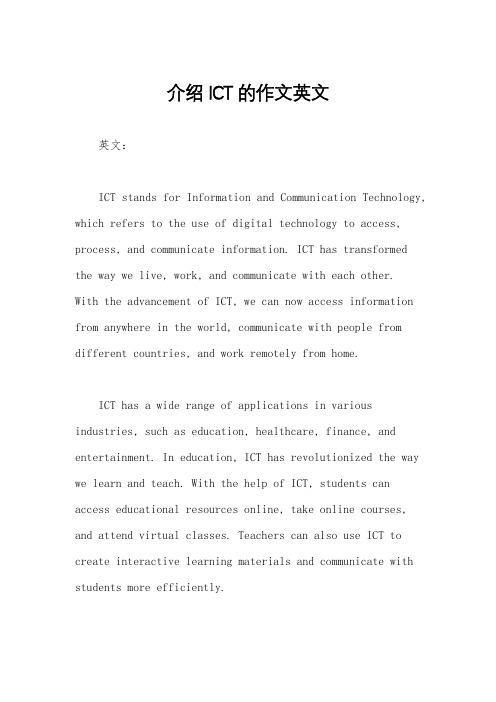
介绍ICT的作文英文英文:ICT stands for Information and Communication Technology, which refers to the use of digital technology to access, process, and communicate information. ICT has transformed the way we live, work, and communicate with each other.With the advancement of ICT, we can now access information from anywhere in the world, communicate with people from different countries, and work remotely from home.ICT has a wide range of applications in various industries, such as education, healthcare, finance, and entertainment. In education, ICT has revolutionized the way we learn and teach. With the help of ICT, students can access educational resources online, take online courses, and attend virtual classes. Teachers can also use ICT to create interactive learning materials and communicate with students more efficiently.In healthcare, ICT has improved the efficiency and quality of healthcare services. Electronic health records (EHRs) have made it easier for healthcare providers to access and share patient information, resulting in better coordination of care. Telemedicine, which uses ICT to provide healthcare services remotely, has also become more popular in recent years.In finance, ICT has enabled the development of online banking, mobile payments, and cryptocurrency. With the help of ICT, we can now transfer money, pay bills, and invest in stocks and bonds online. Cryptocurrency, such as Bitcoin, has also emerged as a new form of digital currency that is based on blockchain technology.In entertainment, ICT has created new forms of mediaand entertainment, such as social media, streaming services, and video games. With the help of ICT, we can now connect with friends and family on social media, watch movies andTV shows on streaming services, and play video games online with people from all over the world.Overall, ICT has had a profound impact on our lives and has transformed the way we live, work, and communicate with each other.中文:ICT代表信息和通信技术,指的是使用数字技术来访问、处理和传递信息。
英文版行业报告
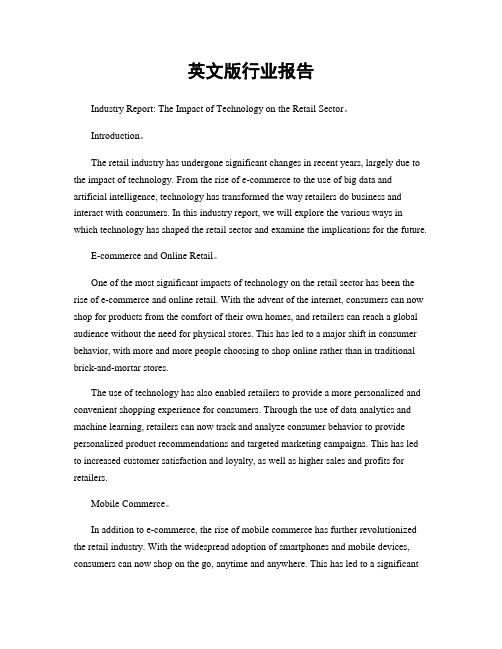
英文版行业报告Industry Report: The Impact of Technology on the Retail Sector。
Introduction。
The retail industry has undergone significant changes in recent years, largely due to the impact of technology. From the rise of e-commerce to the use of big data and artificial intelligence, technology has transformed the way retailers do business and interact with consumers. In this industry report, we will explore the various ways in which technology has shaped the retail sector and examine the implications for the future.E-commerce and Online Retail。
One of the most significant impacts of technology on the retail sector has been the rise of e-commerce and online retail. With the advent of the internet, consumers can now shop for products from the comfort of their own homes, and retailers can reach a global audience without the need for physical stores. This has led to a major shift in consumer behavior, with more and more people choosing to shop online rather than in traditional brick-and-mortar stores.The use of technology has also enabled retailers to provide a more personalized and convenient shopping experience for consumers. Through the use of data analytics and machine learning, retailers can now track and analyze consumer behavior to provide personalized product recommendations and targeted marketing campaigns. This has led to increased customer satisfaction and loyalty, as well as higher sales and profits for retailers.Mobile Commerce。
介绍ICT的作文英文
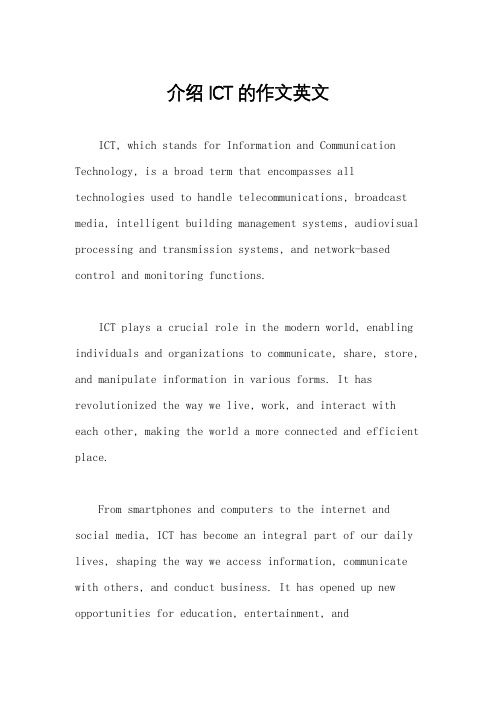
介绍ICT的作文英文ICT, which stands for Information and Communication Technology, is a broad term that encompasses all technologies used to handle telecommunications, broadcast media, intelligent building management systems, audiovisual processing and transmission systems, and network-based control and monitoring functions.ICT plays a crucial role in the modern world, enabling individuals and organizations to communicate, share, store, and manipulate information in various forms. It has revolutionized the way we live, work, and interact with each other, making the world a more connected and efficient place.From smartphones and computers to the internet and social media, ICT has become an integral part of our daily lives, shaping the way we access information, communicate with others, and conduct business. It has opened up new opportunities for education, entertainment, andcollaboration, while also posing challenges related to privacy, security, and digital divide.In the business world, ICT has transformed the way companies operate, allowing them to streamline processes, improve productivity, and reach a wider audience. It hasalso paved the way for new business models, such as e-commerce and telecommuting, and has facilitated the rise of digital nomads and remote work.In the field of education, ICT has revolutionized the way students learn and teachers teach, offering new tools and platforms for interactive and personalized learning experiences. It has also expanded access to education, breaking down geographical barriers and providing opportunities for lifelong learning.In conclusion, ICT has had a profound impact on society, reshaping the way we communicate, work, learn, and do business. As technology continues to advance, it is important for individuals and organizations to adapt and harness the power of ICT for the benefit of all.。
商务英语市场调研报告范文模板
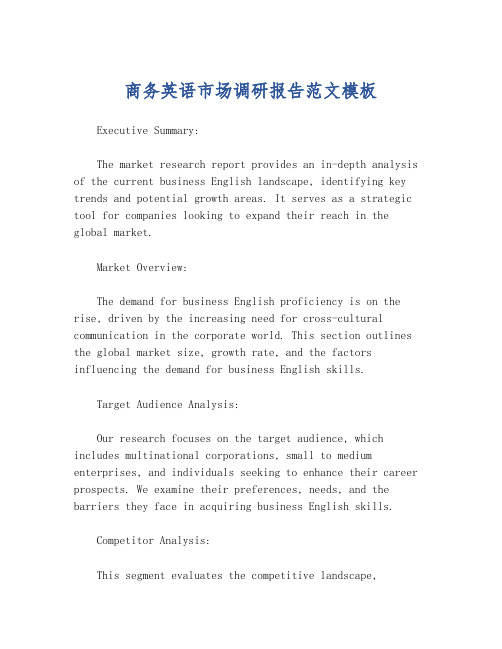
商务英语市场调研报告范文模板Executive Summary:The market research report provides an in-depth analysis of the current business English landscape, identifying key trends and potential growth areas. It serves as a strategic tool for companies looking to expand their reach in the global market.Market Overview:The demand for business English proficiency is on the rise, driven by the increasing need for cross-cultural communication in the corporate world. This section outlines the global market size, growth rate, and the factors influencing the demand for business English skills.Target Audience Analysis:Our research focuses on the target audience, which includes multinational corporations, small to medium enterprises, and individuals seeking to enhance their career prospects. We examine their preferences, needs, and the barriers they face in acquiring business English skills.Competitor Analysis:This segment evaluates the competitive landscape,identifying key players in the business English training market. It assesses their market share, strengths, weaknesses, and strategies to capture a larger audience.Methodology:Our methodology incorporates both qualitative and quantitative research techniques, including surveys, interviews, and data analysis. This ensures a comprehensive understanding of the market dynamics and consumer behavior.Market Trends and Opportunities:The report highlights emerging trends such as the integration of technology in business English learning andthe growing preference for online platforms. It alsoidentifies untapped opportunities for new entrants andexisting players to innovate and differentiate theirofferings.Challenges and Recommendations:Despite the promising outlook, the business Englishmarket faces challenges such as the need for standardized curriculum and the accessibility of resources. The report concludes with actionable recommendations for stakeholders to overcome these hurdles and capitalize on market opportunities.Conclusion:The business English market is poised for continuedgrowth, presenting a lucrative opportunity for educators and businesses alike. By leveraging the insights from this report, organizations can tailor their strategies to meet theevolving needs of the global workforce.。
肯尼亚ICT行业市场调查报告英文

Telcos and telco channels are now selling PCs.
Copyright IDC. Reproduction is forbidden unless authorized. All rights reserved.
Owing to having a good foothold in their parent regions, coupled with access to industry best practices, fairly solid skills bases and access to capital, such companies have been able to target the market segment that includes multinational companies (MNCs), large enterprises and government, where such credentials bear heavily on decision making atKenya ICT Ecosystem Highlights 1/2
There are an estimated 20-30 vendors present in the market most of whom rely on a small pool of major distributors and Tier 1 Value Added Resellers (VARs) and Dealers who combined account for the bulk of ICT Business in Kenya estimated at nearly 50-60%.
英文市场调查报告
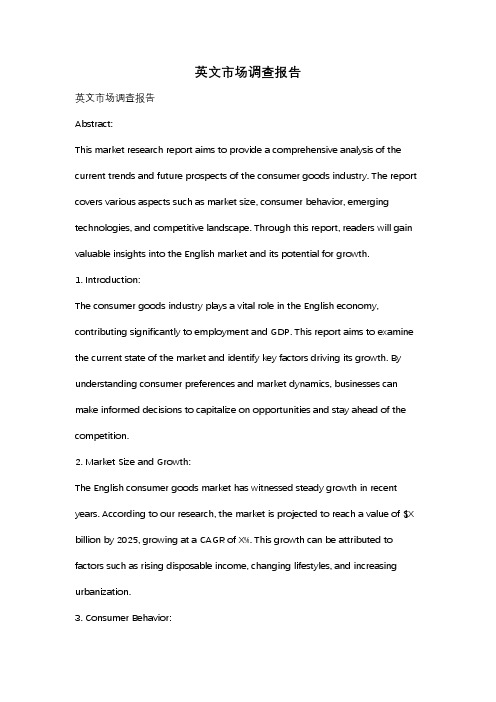
英文市场调查报告英文市场调查报告Abstract:This market research report aims to provide a comprehensive analysis of the current trends and future prospects of the consumer goods industry. The report covers various aspects such as market size, consumer behavior, emerging technologies, and competitive landscape. Through this report, readers will gain valuable insights into the English market and its potential for growth.1. Introduction:The consumer goods industry plays a vital role in the English economy, contributing significantly to employment and GDP. This report aims to examine the current state of the market and identify key factors driving its growth. By understanding consumer preferences and market dynamics, businesses can make informed decisions to capitalize on opportunities and stay ahead of the competition.2. Market Size and Growth:The English consumer goods market has witnessed steady growth in recent years. According to our research, the market is projected to reach a value of $X billion by 2025, growing at a CAGR of X%. This growth can be attributed to factors such as rising disposable income, changing lifestyles, and increasing urbanization.3. Consumer Behavior:Understanding consumer behavior is crucial for businesses to develop effective marketing strategies. Our survey reveals that price, quality, and brand reputation are the primary factors influencing purchasing decisions among English consumers. Additionally, there is a growing demand for eco-friendly and sustainable products, indicating a shift towards more conscious consumption. 4. Emerging Technologies:Technological advancements have had a profound impact on the consumer goods industry. Our research highlights the increasing adoption of e-commerce, mobile applications, and social media platforms for product discovery and purchase. Furthermore, the integration of artificial intelligence and big data analytics is revolutionizing supply chain management and personalized marketing strategies.5. Competitive Landscape:The English consumer goods market is highly competitive, with both domestic and international players vying for market share. Our analysis reveals that key players in the market include Company A, Company B, and Company C. These companies have established strong brand presence and offer a diverse range of products to cater to the evolving consumer demands.6. Opportunities and Challenges:Despite the promising growth prospects, the consumer goods industry in England faces several challenges. The rising cost of raw materials, increasing competition, and regulatory pressures pose significant hurdles for businesses.However, there are ample opportunities for innovation and expansion, particularly in the areas of health and wellness products, personalized marketing, and online retail.7. Conclusion:In conclusion, the English consumer goods market presents an array of opportunities for businesses willing to adapt to changing consumer preferences and embrace emerging technologies. By leveraging the insights provided in this report, companies can develop strategies to drive growth, enhance customer satisfaction, and stay ahead in this dynamic market.。
行业报告英语
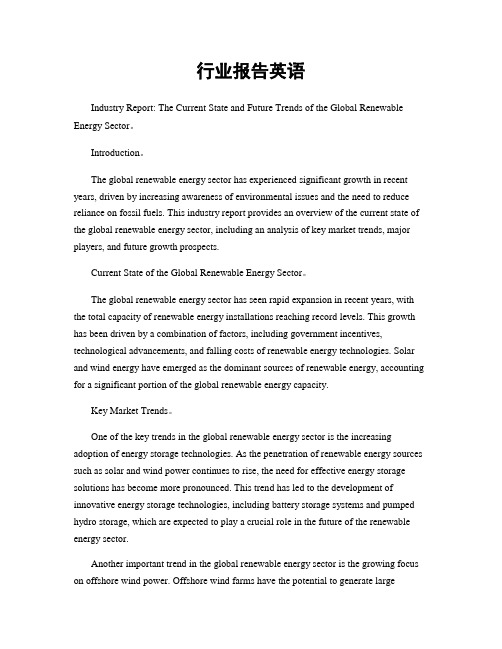
行业报告英语Industry Report: The Current State and Future Trends of the Global Renewable Energy Sector。
Introduction。
The global renewable energy sector has experienced significant growth in recent years, driven by increasing awareness of environmental issues and the need to reduce reliance on fossil fuels. This industry report provides an overview of the current state of the global renewable energy sector, including an analysis of key market trends, major players, and future growth prospects.Current State of the Global Renewable Energy Sector。
The global renewable energy sector has seen rapid expansion in recent years, with the total capacity of renewable energy installations reaching record levels. This growth has been driven by a combination of factors, including government incentives, technological advancements, and falling costs of renewable energy technologies. Solar and wind energy have emerged as the dominant sources of renewable energy, accounting for a significant portion of the global renewable energy capacity.Key Market Trends。
牛津调研报告英文
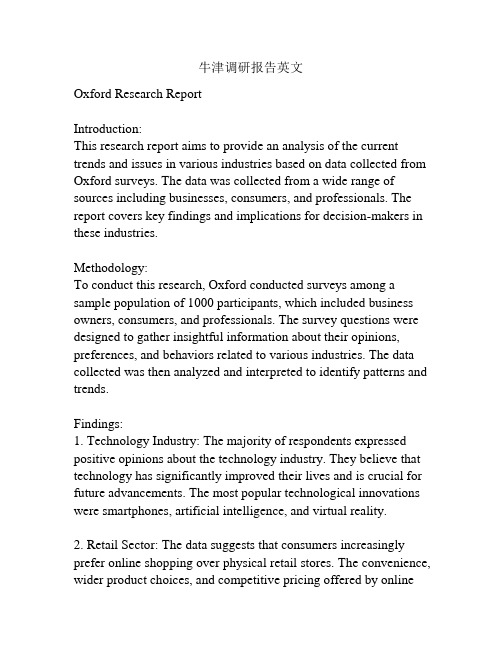
牛津调研报告英文Oxford Research ReportIntroduction:This research report aims to provide an analysis of the current trends and issues in various industries based on data collected from Oxford surveys. The data was collected from a wide range of sources including businesses, consumers, and professionals. The report covers key findings and implications for decision-makers in these industries.Methodology:To conduct this research, Oxford conducted surveys among a sample population of 1000 participants, which included business owners, consumers, and professionals. The survey questions were designed to gather insightful information about their opinions, preferences, and behaviors related to various industries. The data collected was then analyzed and interpreted to identify patterns and trends.Findings:1. Technology Industry: The majority of respondents expressed positive opinions about the technology industry. They believe that technology has significantly improved their lives and is crucial for future advancements. The most popular technological innovations were smartphones, artificial intelligence, and virtual reality.2. Retail Sector: The data suggests that consumers increasingly prefer online shopping over physical retail stores. The convenience, wider product choices, and competitive pricing offered by onlineretailers were identified as the main reasons. This trend has led to a decline in the profitability of brick-and-mortar stores.3. Automotive Industry: Respondents expressed growing concerns about the environmental impact of traditional automobiles. Many participants are considering or have already transitioned to electric or hybrid vehicles. This trend indicates a potential shift towards a more sustainable and eco-friendly automotive industry.4. Healthcare Sector: The majority of respondents were satisfied with the quality of healthcare services available. However, they highlighted concerns about the rising cost of healthcare and the accessibility of medical facilities, especially in remote areas. This suggests the need for more affordable and accessible healthcare options.5. Hospitality and Tourism Industry: The data indicates a significant boost in the hospitality and tourism industry due to increased travel and international tourism. Respondents emphasized the importance of sustainable tourism practices and expressed a growing interest in eco-friendly accommodation options.6. Financial Sector: The research found that a significant number of individuals are interested in digital banking services. The convenience, security, and flexibility offered by online banking platforms were identified as the primary reasons. This indicates a potential shift towards a digital-first banking industry. Implications:1. Businesses in the technology industry should continue to focus on innovation to meet the evolving demands of consumers.2. Retail businesses should invest in online platforms and offer competitive pricing to remain relevant and attract customers.3. The automotive industry should accelerate the development of sustainable alternatives to cater to the increasing demand for eco-friendly transportation.4. Healthcare providers should address the rising cost and accessibility concerns to meet the healthcare needs of all individuals.5. The hospitality and tourism industry should prioritize sustainable practices to attract environmentally conscious travelers.6. The financial sector should invest in digital banking services to cater to the changing preferences and expectations of customers. Conclusion:The Oxford research report indicates significant shifts and trends in various industries. Businesses and decision-makers should pay attention to these findings and adapt their strategies to meet changing consumer demands. These insights and implications can serve as a valuable tool for strategic planning and decision-making.。
- 1、下载文档前请自行甄别文档内容的完整性,平台不提供额外的编辑、内容补充、找答案等附加服务。
- 2、"仅部分预览"的文档,不可在线预览部分如存在完整性等问题,可反馈申请退款(可完整预览的文档不适用该条件!)。
- 3、如文档侵犯您的权益,请联系客服反馈,我们会尽快为您处理(人工客服工作时间:9:00-18:30)。
Copyright IDC. Reproduction is forbidden unless authorized. All rights reserved.
Copyright IDC. Reproduction is forbidden unless authorized. All rights reserved.
On average PC and Printer vendors each have between three to four distributors and at least six other partners (dealers and systems integrators) each at different market levels.
Timely – to augment development of existing KICTB projects – Pasha centres (rural access) , Tandaa (digital content), Wezesha (asset financing) as well as other government ICT initiatives
10
Kenya ICT Ecosystem Highlights 1/2
There are an estimated 20-30 vendors present in the market most of whom rely on a small pool of major distributors and Tier 1 Value Added Resellers (VARs) and Dealers who combined account for the bulk of ICT Business in Kenya estimated at nearly 50-60%.
At the lower part of the pyramid are Tier 2 VARs and dealers, estimated to number more than 100 players and whose focus is part of the SME segment, the SMME and home user segment. These are players who typically do not have a country wide presence and would largely be found operating at a provincial level or even a national level (where SMEs have such a presence to require nationwide services) but at a smaller scale nonetheless.
Survey Highlights
Aims to provide ground-breaking primary research that encompasses numerous market sub -segments and different stakeholders
It will leverage on existing secondary market research in order to consolidate existing discrete market information
Compiling a baseline of key ICT KPIs
Benchmarking key Kenya ICT indicators against six countries
Understanding the ICT Skills availability, demand and gaps
Background
Survey Objectives
Understanding the Kenyan ICT Ecosystem and trends in the market.
Sizing the ICT Market and its sub segments (hardware, software, services, etc) in Kenya.
Copyright IDC. Reproduction is forbidden unless authorized. All rights reserved.
•Kenya ICT ຫໍສະໝຸດ arket OverviewCopyright IDC. Reproduction is forbidden unless authorized. All rights reserved.
8
•Kenya ICT Ecosystem
Copyright IDC. Reproduction is forbidden unless authorized. All rights reserved.
9
Kenya ICT Ecosystem Structure
Copyright IDC. Reproduction is forbidden unless authorized. All rights reserved.
Copyright IDC. Reproduction is forbidden unless authorized. All rights reserved.
7
Market Overview Spending by Vertical Sectors
Copyright IDC. Reproduction is forbidden unless authorized. All rights reserved.
5
Market Overview Kenya ICT Market Key Indicators
Copyright IDC. Reproduction is forbidden unless authorized. All rights reserved.
6
Market Overview ICT Spending by Technology Areas
It will have a repeat cycle to gauge the progress and impact of KICTB and other stakeholders’ initiatives.
The survey is consultative as well – where multiple stakeholders are both respondents (i.e. What are your issues?) and also beneficiaries (i.e. What to do?)
